§ Stars
Page 2"We had the sky up there, all speckled with stars, and we used to lay on our backs and look up at them, and discuss about whether they was made or only just happened. Jim he allowed they was made, but I allowed they happened; I judged it would have took too long to make so many. Jim said the moon could a laid them; well, that looked kind of reasonable, so I didn't say nothing against it, because I've seen a frog lay most as many, so of course it could be done." - from the Adventures of Huckleberry Finn, Mark Twain
§ Contents
- You Should Know — Star Terminology & Information
In This Section You Should Know — Definitions from the Astronomical Science of Stars - Stars — Introduction
A Jeweled Pair — Albireo A & B - The Stellar Classification of Stars
The H-R Diagram — O, B, A, F, G, K, and M - History of the H-R Diagram
Amateur Astronomer: Ejnar Hertzsprung — Influential Astronomer: Henry Norris Russell - History of the H-R Diagram...continued
Amateur Astronomer: Ejnar Hertzsprung — Influential Astronomer: Henry Norris Russell - Evolution within an Evolving Universe
Evolution of the Universe & Universal Evolution — Stellar Evolution - Spectral Classification of Stars
Star HD 66171 — Spectral Classification, Counting Photons - The Luminosity Class
Luminosity class, A Star's Radius & Temperature — Apparent Magnitude - Sources & Further Study
Additional Resources - Star Types
Introduction to Star Types — Most of the Older Pages Displayed, Revisions in Progress
5. History of the H-R Diagram...continued
"Sharp-witted and animated by nervous energy, he became one of the most powerful voices in twentieth-century American astronomy, wielding that influence in calculated ways to redefine an entire science. He, more than any American of his generation, worked to turn an observation-centered discipline into a theory-driven pursuit centered on physics." — Princeton University Press, 2009
Henry Norris Russell
Dean of American Astronomers
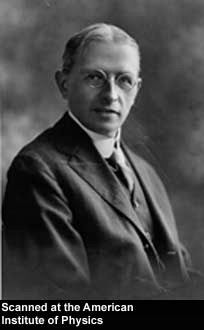
 Born in Oyster Bay, New York, Henry Norris Russell began his academic studies in astronomy at Princeton University where he obtained his B.A. in 1897 and his doctorate degree in 1899 while working under the contemporary astronomer Charles A. Young who had encouraged Russell to think of the universe in evolutionary terms, to view it as a developing and continuing cycle of stellar life and death, looking further ahead, beyond any single cause for it's existence. In 1902, Russell travelled to Cambridge, England to study and from 1903 to 1905, worked at the Cambridge Observatory with Arthur Robert Hinks ( senior assistant there from 1903-1913 ) as a research assistant of the Carnegie Institution, coming under the influence of Sir George Darwin ( image right ) whose ideas and work had been at the heart of Young's eariler encouragment of Russell. fn1
Born in Oyster Bay, New York, Henry Norris Russell began his academic studies in astronomy at Princeton University where he obtained his B.A. in 1897 and his doctorate degree in 1899 while working under the contemporary astronomer Charles A. Young who had encouraged Russell to think of the universe in evolutionary terms, to view it as a developing and continuing cycle of stellar life and death, looking further ahead, beyond any single cause for it's existence. In 1902, Russell travelled to Cambridge, England to study and from 1903 to 1905, worked at the Cambridge Observatory with Arthur Robert Hinks ( senior assistant there from 1903-1913 ) as a research assistant of the Carnegie Institution, coming under the influence of Sir George Darwin ( image right ) whose ideas and work had been at the heart of Young's eariler encouragment of Russell. fn1
Returning to Princeton in 1905, he was appointed an instructor in astronomy by Woodrow Wilson and in November of 1908 he married Lucy May Cole whom had four children. Their youngest child, daughter Margaret, eventually married the astronomer Frank K. Edmondson in the 1930's. Meanwhile, Russell was appointed as an assistant professor in 1908, attained a full professorship in 1911 and was appointed as a research professor in 1927, a position he maintained till 1947. He was also the director of the Princeton University Observatory from 1912 to 1947. Called the "Dean of American Astronomers" by many and known also as the "General" by colleagues Henry Norris Russell died in Princeton, New Jersey in 1957 at the age of 79. Image of Henry Norris Russell courtesy of the AIP Emilio Segre Visual Archives, W. F. Meggers Collection [14]
Prior to Hertzsprung and Russell, there existed a previous method of stellar classification called the "Secchi classes" ( Secchi, 1863—67 ) which was a method that grouped stellar spectra into four classes, depending on the absorption lines seen. However, this was superseded by the Harvard classification scheme in the late 1890s, and later improved upon by the H-R diagram in 1911-13 and the Yerkes spectral classification of 1943. Since that time, the only major revision to these diagrams were an extended spectral listing for newly discovered types of stars, a result of 20th century technological advancements. [15]
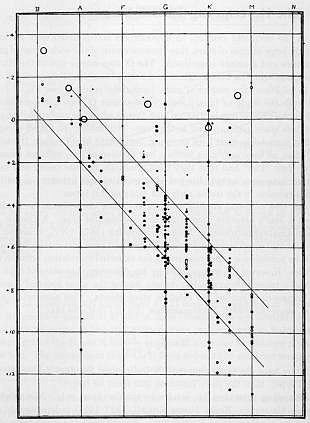 During the same period that Hertzprung was developing his chart, Henry Russell, working at Princeton University with a large amount of star data, independently come to the same conclusion as Hertzsprung and in 1913 published his own star spectra & magnitude diagram. On Russell's chart, shown at right, he listed the spectral types along the top and the absolute magnitudes on the left-hand side and what he found was that in a diagram of a stars' luminosity versus it's temperature, you get a nearly straight line, with the most luminous stars being the hottest and the least luminous, the coolest; the area on the chart where the largest group of stars fell along this line is called the main sequence. The development of the H—R diagram became a very powerful tool for astronomers as the grouping of a universe worth of stars into a managable scheme of classification was all but impossible due to sheer weight of numbers alone.
During the same period that Hertzprung was developing his chart, Henry Russell, working at Princeton University with a large amount of star data, independently come to the same conclusion as Hertzsprung and in 1913 published his own star spectra & magnitude diagram. On Russell's chart, shown at right, he listed the spectral types along the top and the absolute magnitudes on the left-hand side and what he found was that in a diagram of a stars' luminosity versus it's temperature, you get a nearly straight line, with the most luminous stars being the hottest and the least luminous, the coolest; the area on the chart where the largest group of stars fell along this line is called the main sequence. The development of the H—R diagram became a very powerful tool for astronomers as the grouping of a universe worth of stars into a managable scheme of classification was all but impossible due to sheer weight of numbers alone.
This was all fine and well, but as more and more groups of stars were placed on the chart, something else developed which was also inherent to the use of the H-R diagram. A small percentage of the stars in the chart began falling outside the main sequence. These were the stars that, as a result of the nature of their stellar evoluntion, were both very luminous yet much cooler, called Red Giants, like the star Betelgeuse, or those that conversely, proved to be really hot yet very dim, called White Dwarfs, like the star IK Pegasi B. These exceptions, like the white dwarf types, led astronomers over the years to develope general theories and conclusions, especially regarding the universe and it's age. Using an analogy, Terry D. Oswalt, professor of physics and space sciences at the Florida Institute of Technology noted:
"Think of a cup of coffee. When first poured, it is very hot, but as time goes on the temperature falls. If you know how fast a cup of coffee cools, you can measure its present temperature and determine how long it has been since it was poured. The color of a White Dwarf is easy to measure, and it directly tells us its temperature. The redder it is, the cooler it is--therefore the older it is."
"Curiously, we find no White Dwarfs cooler than about 4,000 Kelvins. It takes a White Dwarf about 10 billion years to cool to this temperature. So we conclude that even the first generation of stars in our galaxy, whose remnants are now White Dwarfs, have not had a chance to cool below 4,000 Kelvins. By that reckoning, the galaxy, and hence the whole universe, must be at least 10 billion years old." [16]
Eduacation and the H—R Diagram
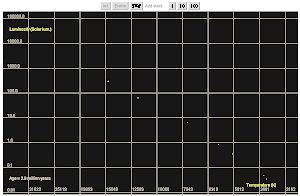 Since it's always helpful to get some hands on practice, try clicking on the image at left. This link opens in a separate window at the University of British Columbia where they have created an HR Diagram Simulator which allows you to place 1, 10 or 100 stars on the main sequence, allowing you to compare their evolution off the main sequence either in steps or as a movie. You will also find below, three more sites with simulators demostrating the use of the H-R Diagram. All are interactive and teach a diffrerent aspect of star plotting, the results which vary according to each simulator's goal. The simulator at the University of New Mexico is extremely well done, both visually and educationally, and is part of a larger lab program.
Since it's always helpful to get some hands on practice, try clicking on the image at left. This link opens in a separate window at the University of British Columbia where they have created an HR Diagram Simulator which allows you to place 1, 10 or 100 stars on the main sequence, allowing you to compare their evolution off the main sequence either in steps or as a movie. You will also find below, three more sites with simulators demostrating the use of the H-R Diagram. All are interactive and teach a diffrerent aspect of star plotting, the results which vary according to each simulator's goal. The simulator at the University of New Mexico is extremely well done, both visually and educationally, and is part of a larger lab program.
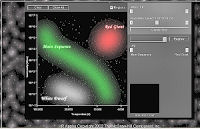
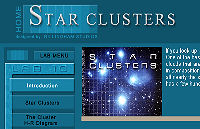
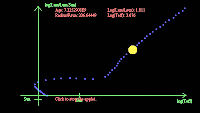
From left to right are 1) Stellar Evolution and the H-R- Diagram — from The McGraw-Hill Companies, Inc., 2) Astronomy Lab 101L, an education lab series applet from the University of New Mexico's Department of Physics & Astronomy and 3) University of Durham, United Kingdom, an applet that visualizes a star's life cycle by following the evolution of the star's Age, Luminosity, Radius and Effective Temperature using a single plotting track.
Dean of American Astronomers

 Born in Oyster Bay, New York, Henry Norris Russell began his academic studies in astronomy at Princeton University where he obtained his B.A. in 1897 and his doctorate degree in 1899 while working under the contemporary astronomer Charles A. Young who had encouraged Russell to think of the universe in evolutionary terms, to view it as a developing and continuing cycle of stellar life and death, looking further ahead, beyond any single cause for it's existence. In 1902, Russell travelled to Cambridge, England to study and from 1903 to 1905, worked at the Cambridge Observatory with Arthur Robert Hinks ( senior assistant there from 1903-1913 ) as a research assistant of the Carnegie Institution, coming under the influence of Sir George Darwin ( image right ) whose ideas and work had been at the heart of Young's eariler encouragment of Russell. fn1
Born in Oyster Bay, New York, Henry Norris Russell began his academic studies in astronomy at Princeton University where he obtained his B.A. in 1897 and his doctorate degree in 1899 while working under the contemporary astronomer Charles A. Young who had encouraged Russell to think of the universe in evolutionary terms, to view it as a developing and continuing cycle of stellar life and death, looking further ahead, beyond any single cause for it's existence. In 1902, Russell travelled to Cambridge, England to study and from 1903 to 1905, worked at the Cambridge Observatory with Arthur Robert Hinks ( senior assistant there from 1903-1913 ) as a research assistant of the Carnegie Institution, coming under the influence of Sir George Darwin ( image right ) whose ideas and work had been at the heart of Young's eariler encouragment of Russell. fn1Returning to Princeton in 1905, he was appointed an instructor in astronomy by Woodrow Wilson and in November of 1908 he married Lucy May Cole whom had four children. Their youngest child, daughter Margaret, eventually married the astronomer Frank K. Edmondson in the 1930's. Meanwhile, Russell was appointed as an assistant professor in 1908, attained a full professorship in 1911 and was appointed as a research professor in 1927, a position he maintained till 1947. He was also the director of the Princeton University Observatory from 1912 to 1947. Called the "Dean of American Astronomers" by many and known also as the "General" by colleagues Henry Norris Russell died in Princeton, New Jersey in 1957 at the age of 79. Image of Henry Norris Russell courtesy of the AIP Emilio Segre Visual Archives, W. F. Meggers Collection [14]
Prior to Hertzsprung and Russell, there existed a previous method of stellar classification called the "Secchi classes" ( Secchi, 1863—67 ) which was a method that grouped stellar spectra into four classes, depending on the absorption lines seen. However, this was superseded by the Harvard classification scheme in the late 1890s, and later improved upon by the H-R diagram in 1911-13 and the Yerkes spectral classification of 1943. Since that time, the only major revision to these diagrams were an extended spectral listing for newly discovered types of stars, a result of 20th century technological advancements. [15]
 During the same period that Hertzprung was developing his chart, Henry Russell, working at Princeton University with a large amount of star data, independently come to the same conclusion as Hertzsprung and in 1913 published his own star spectra & magnitude diagram. On Russell's chart, shown at right, he listed the spectral types along the top and the absolute magnitudes on the left-hand side and what he found was that in a diagram of a stars' luminosity versus it's temperature, you get a nearly straight line, with the most luminous stars being the hottest and the least luminous, the coolest; the area on the chart where the largest group of stars fell along this line is called the main sequence. The development of the H—R diagram became a very powerful tool for astronomers as the grouping of a universe worth of stars into a managable scheme of classification was all but impossible due to sheer weight of numbers alone.
During the same period that Hertzprung was developing his chart, Henry Russell, working at Princeton University with a large amount of star data, independently come to the same conclusion as Hertzsprung and in 1913 published his own star spectra & magnitude diagram. On Russell's chart, shown at right, he listed the spectral types along the top and the absolute magnitudes on the left-hand side and what he found was that in a diagram of a stars' luminosity versus it's temperature, you get a nearly straight line, with the most luminous stars being the hottest and the least luminous, the coolest; the area on the chart where the largest group of stars fell along this line is called the main sequence. The development of the H—R diagram became a very powerful tool for astronomers as the grouping of a universe worth of stars into a managable scheme of classification was all but impossible due to sheer weight of numbers alone.This was all fine and well, but as more and more groups of stars were placed on the chart, something else developed which was also inherent to the use of the H-R diagram. A small percentage of the stars in the chart began falling outside the main sequence. These were the stars that, as a result of the nature of their stellar evoluntion, were both very luminous yet much cooler, called Red Giants, like the star Betelgeuse, or those that conversely, proved to be really hot yet very dim, called White Dwarfs, like the star IK Pegasi B. These exceptions, like the white dwarf types, led astronomers over the years to develope general theories and conclusions, especially regarding the universe and it's age. Using an analogy, Terry D. Oswalt, professor of physics and space sciences at the Florida Institute of Technology noted:
"Think of a cup of coffee. When first poured, it is very hot, but as time goes on the temperature falls. If you know how fast a cup of coffee cools, you can measure its present temperature and determine how long it has been since it was poured. The color of a White Dwarf is easy to measure, and it directly tells us its temperature. The redder it is, the cooler it is--therefore the older it is."
"Curiously, we find no White Dwarfs cooler than about 4,000 Kelvins. It takes a White Dwarf about 10 billion years to cool to this temperature. So we conclude that even the first generation of stars in our galaxy, whose remnants are now White Dwarfs, have not had a chance to cool below 4,000 Kelvins. By that reckoning, the galaxy, and hence the whole universe, must be at least 10 billion years old." [16]
Eduacation and the H—R Diagram
 Since it's always helpful to get some hands on practice, try clicking on the image at left. This link opens in a separate window at the University of British Columbia where they have created an HR Diagram Simulator which allows you to place 1, 10 or 100 stars on the main sequence, allowing you to compare their evolution off the main sequence either in steps or as a movie. You will also find below, three more sites with simulators demostrating the use of the H-R Diagram. All are interactive and teach a diffrerent aspect of star plotting, the results which vary according to each simulator's goal. The simulator at the University of New Mexico is extremely well done, both visually and educationally, and is part of a larger lab program.
Since it's always helpful to get some hands on practice, try clicking on the image at left. This link opens in a separate window at the University of British Columbia where they have created an HR Diagram Simulator which allows you to place 1, 10 or 100 stars on the main sequence, allowing you to compare their evolution off the main sequence either in steps or as a movie. You will also find below, three more sites with simulators demostrating the use of the H-R Diagram. All are interactive and teach a diffrerent aspect of star plotting, the results which vary according to each simulator's goal. The simulator at the University of New Mexico is extremely well done, both visually and educationally, and is part of a larger lab program.


From left to right are 1) Stellar Evolution and the H-R- Diagram — from The McGraw-Hill Companies, Inc., 2) Astronomy Lab 101L, an education lab series applet from the University of New Mexico's Department of Physics & Astronomy and 3) University of Durham, United Kingdom, an applet that visualizes a star's life cycle by following the evolution of the star's Age, Luminosity, Radius and Effective Temperature using a single plotting track.
 Several browser searches later and the difference was crystal clear — that was, of course, after realizing the initial mistake in the order of the words submitted for the search engine to query. Says Wikipedia,
Several browser searches later and the difference was crystal clear — that was, of course, after realizing the initial mistake in the order of the words submitted for the search engine to query. Says Wikipedia, 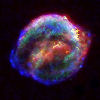 Evolution of the Universe is ( generally speaking ) scientists peering into and surveying the universe, analyzing and exploring the workings of outer space, imaging the mulitutde of galaxies, taking spectrum of stars, researching the composition of stellar gases, matter, planets and yes, even the life and material which form this world we call Earth; it is the theory of how the universe itself came to be. Current scientific thinking has put forward three relevant theories in explaining the origin and evolution of the universe. Without delving into those at the moment, they are:
Evolution of the Universe is ( generally speaking ) scientists peering into and surveying the universe, analyzing and exploring the workings of outer space, imaging the mulitutde of galaxies, taking spectrum of stars, researching the composition of stellar gases, matter, planets and yes, even the life and material which form this world we call Earth; it is the theory of how the universe itself came to be. Current scientific thinking has put forward three relevant theories in explaining the origin and evolution of the universe. Without delving into those at the moment, they are: "The Main Sequence is the location in the HR diagram
"The Main Sequence is the location in the HR diagram Stellar evolution is the process by which a star undergoes a sequence of radical changes during its lifetime. Depending on the mass of the star, this lifetime ranges from a few million years (for the most massive) to trillions of years (for the less massive), considerably more than the age of the universe. The image at left represents the stellar evolution of our own star, the sun.
Stellar evolution is the process by which a star undergoes a sequence of radical changes during its lifetime. Depending on the mass of the star, this lifetime ranges from a few million years (for the most massive) to trillions of years (for the less massive), considerably more than the age of the universe. The image at left represents the stellar evolution of our own star, the sun.
 Stars can be as near to us our own sun, a mere eight light-minutes away, a distance of about 93 million miles, or as far off as SN1997ff, a star that went supernova 11 billion light-years from Earth. At left is a close up of the surface of our own sun and it's solar flux tubes. It is one of the highest resolution images so far taken of the sun's surface. Image Credit:
Stars can be as near to us our own sun, a mere eight light-minutes away, a distance of about 93 million miles, or as far off as SN1997ff, a star that went supernova 11 billion light-years from Earth. At left is a close up of the surface of our own sun and it's solar flux tubes. It is one of the highest resolution images so far taken of the sun's surface. Image Credit: 

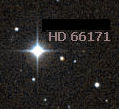 Now we'll need a star which to point our telescope at in order to collect a sample of it's light.
Now we'll need a star which to point our telescope at in order to collect a sample of it's light.
 Therefore, we'll use the star
Therefore, we'll use the star  When we collect star light in order to study the results in the form of a "spectrum" what we are doing is looking at the very particles or atoms that make up the light wave itself. These light waves are actually waves of energy travelling through space at 186,000 miles per second. They are composed of atoms that contain electrons that have a natural orbit around the atom's nucleus. If the atom is energized it moves this electron to a higher orbit and whenever an electron that is in a higher-than-normal orbit falls back to its normal orbit it emits a photon or a small amount of energy with very specific characteristics - the photon has a frequency, or color, that exactly matches the distance the electron falls.
When we collect star light in order to study the results in the form of a "spectrum" what we are doing is looking at the very particles or atoms that make up the light wave itself. These light waves are actually waves of energy travelling through space at 186,000 miles per second. They are composed of atoms that contain electrons that have a natural orbit around the atom's nucleus. If the atom is energized it moves this electron to a higher orbit and whenever an electron that is in a higher-than-normal orbit falls back to its normal orbit it emits a photon or a small amount of energy with very specific characteristics - the photon has a frequency, or color, that exactly matches the distance the electron falls. Absorption is one way an electron can move (or jump) out of and back to it's normal orbit. How this works is simple - if we take the gas Helium and pass light through it on one side, some of the electrons within the atoms of light will move out of their natural orbits, a result of the interaction with the atoms of Helium. As the light is reemitted the electrons return to their natural state. When we measure this emitted light from the gas we will notice that there is less light within a certain wavelength, equating to that of Helium, than in the other wavelengths. When astronomers employ this method in their research, the resulting visual data, collected from the photons of light, is called an absorption spectrum. It is from this that one can determine the Composition, Temperature, Speed of approach, recession and other characteristics of a star.
Absorption is one way an electron can move (or jump) out of and back to it's normal orbit. How this works is simple - if we take the gas Helium and pass light through it on one side, some of the electrons within the atoms of light will move out of their natural orbits, a result of the interaction with the atoms of Helium. As the light is reemitted the electrons return to their natural state. When we measure this emitted light from the gas we will notice that there is less light within a certain wavelength, equating to that of Helium, than in the other wavelengths. When astronomers employ this method in their research, the resulting visual data, collected from the photons of light, is called an absorption spectrum. It is from this that one can determine the Composition, Temperature, Speed of approach, recession and other characteristics of a star.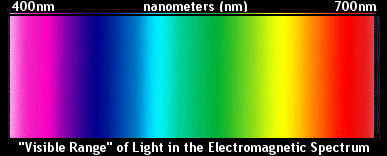 At left is an example of the visible light spectrum ( the range of light within the electromagnetic radiation spectrum that we can see ), arranged in order of the wavelengths of each color, with Violet at 380-450 nm (380-450 Trillion Hz) to Red, at 620-750 nm (620-750 Trillion Hz) with the edges of the visible light spectrum blending into the ultraviolet or infrared levels of radiation.
At left is an example of the visible light spectrum ( the range of light within the electromagnetic radiation spectrum that we can see ), arranged in order of the wavelengths of each color, with Violet at 380-450 nm (380-450 Trillion Hz) to Red, at 620-750 nm (620-750 Trillion Hz) with the edges of the visible light spectrum blending into the ultraviolet or infrared levels of radiation.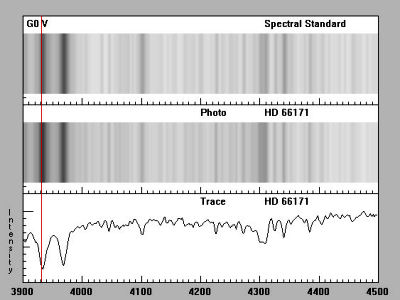 Now that we have determined our star's main spectral class, we can next look at it's temperature. First, we should know that O stars are the hottest, with temperatures over 30,000 Kelvin and M stars are the coolest, with temperatures under 3500 Kelvin. G stars, like our Sun, run in the range 5000-6000 Kelvin. In stellar classification there's a range of temperatures for each of the spectral classes and they are subdivided from hottest to coldest using the numerals 0-9. Thus, a G0 star is hotter than than a G2 star, and a G5 star is hotter than a G9 star. The next step is to establish our star's temperature and though our classification section is based on templates of already established spectral types, it is helpful to understand how this is accomplished. Note: 1 degree Kelvin equals exactly 1.8 degrees Fahrenheit.
Now that we have determined our star's main spectral class, we can next look at it's temperature. First, we should know that O stars are the hottest, with temperatures over 30,000 Kelvin and M stars are the coolest, with temperatures under 3500 Kelvin. G stars, like our Sun, run in the range 5000-6000 Kelvin. In stellar classification there's a range of temperatures for each of the spectral classes and they are subdivided from hottest to coldest using the numerals 0-9. Thus, a G0 star is hotter than than a G2 star, and a G5 star is hotter than a G9 star. The next step is to establish our star's temperature and though our classification section is based on templates of already established spectral types, it is helpful to understand how this is accomplished. Note: 1 degree Kelvin equals exactly 1.8 degrees Fahrenheit.
